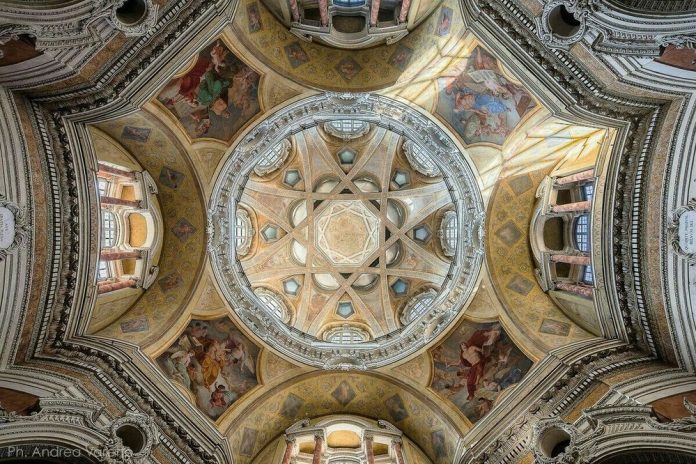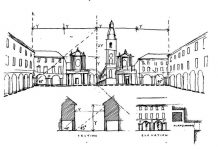In her contribution to the conference Guarino Guarini e l’internazionalità del barocco of 1968, silvia bordini presented a historical overview of the criticism of guarini, claiming at one point that remarks of eighteenth-century writers ‘accomunano guarini nella generale valutazione negative dell’arte barocca’. As bordini rightly claims, this criticism of guarini was indeed part of a broader trend of censuring the work of architects whom we would now characterize as ‘baroque’.
But late-eighteenth-century criticism of guarini was also unique, and in significant ways not discussed by bordini. Prominent theorists – jacques-François blondel, Francesco Milizia, antoine Quatremère de Quincy, and others – made clear distinctions between guarini’s failings and those of other architects, and particularly those of borromini, the architect whom modern scholars most often consider the focus of eighteenth-century criticism. Quatremère de Quincy, in his well-known definition of ‘baroque’ as an architectural term, in fact singled out guarini alone as ‘le maître du baroque’.
My discussion focuses on what made guarini’s architecture unique, and ‘baroque’, in the minds of late-eighteenth-century critics. Such a discussion seeks to reevaluate current perceptions of what the term ‘baroque’ meant when it was introduced into architectural criticism and to recognize the criticism of guarini as a distinctive and crucial part of the formation of these early notions of ‘baroque’ architecture.
In so doing, my discussion also calls for a reappraisal of the significance of Piedmontese architecture in the formation of the concept of ‘baroque’ architecture more generally. In her contribution to the conference Guarino Guarini e l’internazionalità del barocco in 1968, silvia bordini discussed the history of guarini’s reception from the late seventeenth century to the 1960s, and claimed that eighteenthcentury writers’ criticism set guarini within the broader critical attack on architects of his day.
In this paper, I take issue with this claim; I argue instead that guarini held a unique position in eighteenth-century criticism. This uniqueness had to do with what critics perceived as his relation to borromini: guarini came to stand as perhaps the most important model of an architect who followed borromini. This particular idea of guarini is significant because, as I will proceed to show, it was transformed into a fundamental element of Quatremère de Quincy’s concept of the ‘baroque’ in architecture.
Indeed, recognizing the place of the criticism of guarini in the early development of the concept of the ‘baroque’ in architecture indicates that that concept itself needs reconsideration; ‘baroque’ was not to do simply with seemingly overly elaborate architectural forms per se, but rather with a particular mode of imitation of such forms. Overall, then, this paper undertakes to show not only that guarini was a unique figure in eighteenth-century criticism, but that the recognition of this uniqueness allows for a substantial re-evaluation of what ‘baroque’ meant when codified in architectural discourse.
My discussion takes the form of a response to bordini’s paper, but it nonetheless also responds to approaches to the study of guarini in the 1960s more broadly. Bordini spoke of guarini’s relation to borromini as a preoccupation of guarini’s critics from the eighteenth century to the early twentieth century. In scholarship of the 1960s, the subject appears repeatedly in discussions of guarini’s architecture; argan, carboneri, griseri, Millon, and Pommer, as well as a number of other speakers at the 1968 conference on guarini, commented on the relation between the two architects.
My approach differs from that of these scholars in that, instead of attempting to validate or diminish the idea that borromini influenced guarini, I consider the idea of this influence as a historical construct and also seek to show how analyzing this construct as it was presented in eighteenth-century texts yields fruitful insight into architectural theory of the time. I want to begin the discussion by paying closer attention to comments on guarini made by two of the eighteenth-century critics bordini cited, Francesco Milizia in his biography of guarini included in his Le vite de’ più celebri architetti d’ogni nazione e d’ogni tempo (1768) and antoine Quatremère de Quincy in his definition of the term ‘baroque’ in his Encyclopédie méthodique: Architecture (1788).
Bordini implied, and thus rightly perceived, that Quatremère’s reception of guarini was influenced by Milizia’s remarks. At the same time, however, she seems not to have realized the more precise nature of this influence. Milizia’s influence on Quatremère is more apparent if, instead of comparing Quatremère’s text with the original Italian edition of Milizia’s Vite, as bordini did, we compare it with the French translation of Milizia’s text. The line of particular interest is translated from the Italian, ‘se vi è stato mai architetto che abbia portato all’ecesso le stravaganze borrominesche, è certamente il P. Guarino Guarini’, to the French, ‘de tous les architectes qui ont adopté le style bizarre de borromini, il n’en est aucun qui ait donné dans tant d’exèsque le pere guarino guarini’.
The idea of guarini being an architect who took borromini’s extravagance to excess in the Italian edition is transformed in the French into the idea that guarini, of all the architects who took up borromini’s bizarre style, was the one who took it to the greatest excess. Two important shifts take place in this act of translation: borromini moves from being extravagant to being bizarre and guarini goes from being simply one example of a follower of borromini’s who took his faults to excess to being the example, of all of borromini’s followers, who took his faults to the greatest excess.
The idea of bizarreness taken to an extreme, or its superlative form, the association of borromini with bizarreness, and the example of guarini as the architect who took borromini’s bizarreness to an extreme reappear in Quatremère’s definition of ‘baroque’. The relevant parts of his definition are as follows:
le baroque, en architecture, est une nuance du bizarre, il en est, si on veut, le rafinement, ou, s’il étoit [sic] possible de le dire, l’abus. Ce que la sévérité est à la sagesse ou goût, le baroque l’est au bizarre, c’est-à-dire qu’il en est le superlatif. […] Borromini a donné les plus grands modèles de bizarrerie. Guarini peut passer pour le maître du baroque.
Quatremère’s ‘baroque’ thus embodied elements of a pre-existing concept in architectural discourse, this portrayal of guarini as a model of a follower of borromini as presented by Milizia. To this pre-existing concept, Quatremère applied the term ‘baroque’. The term, as we know, was already in use in architectural discourse at the time and had already been defined in an architectural dictionary, but Quatremère’s ‘baroque’ clearly diverged from earlier usage: prior to Quatremère’s definition, the term ‘baroque’ in architectural discourse did not have a clear association with the term ‘bizarre’ and, even while it was associated with the term ‘bizarre’ in more general parlance, it was defined as one of its synonyms, not its superlative.
Moreover, the term had not been applied to guarini in this way that bound its meaning to guarini’s relation to borromini. By constructing a particular semantic relation between ‘baroque’ and ‘bizarre’ and by using guarini’s relationship to borromini to illustrate this relation, Quatremère, on the one hand, created something that was strikingly new in terms of the meaning of the ‘baroque’ in architecture and yet, on the other hand, in part, simply reframed and allotted a term to a pre-existing concept. If we accept Milizia’s, or, more precisely, his translator’s, portrayal of guarini as a source for Quatremère’s ‘baroque’, we must also acknowledge that this portrayal of guarini was not itself either entirely original or unique.
Before the publication of Milizia’s Vite, a number of French writers had identified guarini as an architect who followed or created work in the style of borromini. Moreover, the idea that guarini’s work embodied that which was particularly bad about borromini’s had also been voiced: in his Cours d’architecture (1683), for example, François blondel claimed that guarini not only wanted to follow borromini, but that he had ‘choisi ce qu’il y avoit de plus extravagant dans ses [borromini’s] pratiques’ as well.
Although Milizia’s critique clearly differs from these others in its specification that guarini took borromini’s faults to excess, it nonetheless certainly grew out of such criticisms. The idea that guarini had taken borromini’s faults to excess was, however, no longer unique to Milizia by the time of Quatremère’s publication. In fact, the idea circulated in French texts in the years following the publication of Milizia’s Vite: one writer, for example, claimed that guarini ‘adopta la maniere du borromini, & en chérit sur sa bizarrerie’ and another that, ‘avec moins génie que le boromini [sic], il [guarini] a beaucoup renchéri sur tous les défauts qu’on lui reproche’.
Thus, while particular terms and semantic relations of Quatremère’s definition of ‘baroque’ seem to come directly from Milizia, the ideas about guarini that Quatremère’s term embodied belonged to more long-standing and widespread perceptions of guarini as a follower of borromini’s. Recognizing the link between Quatremère’s definition of ‘baroque’ and the history of the reception of guarini is significant in two ways. First, for our understanding of guarini’s early reception, it underscores that he was viewed as exceptional by eighteenth-century critics, albeit for his failings rather than his merits.
Second, in terms of our understanding of eighteenth-century architectural theory more generally, recognizing the link between Quatremère and guarini’s reception shifts the context within which we understand Quatremère’s concept of the ‘baroque’. Early studies of the development of the broader concept of ‘baroque’ treated Quatremère’s definition as just one of many examples of the etymology and usage of the term, and in so doing created what became a standard framework within which his definition was understood.
Perhaps as a result, subsequent scholars have failed to recognize that Quatremère did not simply absorb the meaning of ‘baroque’ from general parlance into architectural discourse. Rather, he created a new meaning of ‘baroque’ that was specific to architecture and, moreover, he did so by endowing it with an idea that was current in architectural discourse, yet for which there was no specific term. In particular, Quatremère created terminology that described architecture that was perceived as imitative of and worse than that of borromini, a broader phenomenon of which guarini was a prime example.
Marion Riggs
Independent scholar, Italy



















